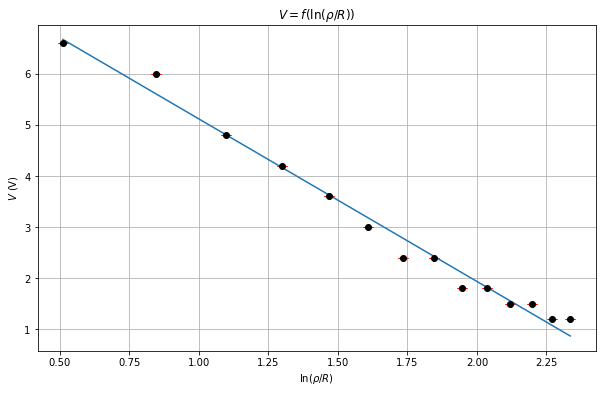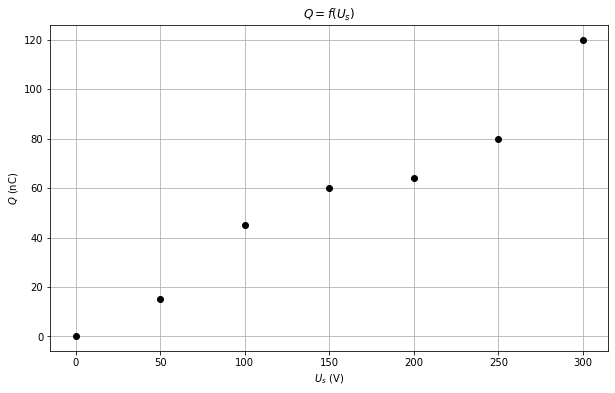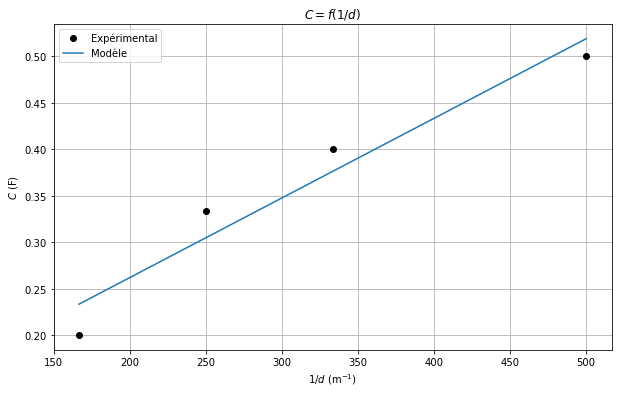TP1 - Champ électrique#
ARGUELLO Camilo#
import numpy as np
import matplotlib.pyplot as plt
from scipy.optimize import minimize, curve_fit
from IPython.display import display, Math
---------------------------------------------------------------------------
ModuleNotFoundError Traceback (most recent call last)
Cell In[1], line 3
1 import numpy as np
2 import matplotlib.pyplot as plt
----> 3 from scipy.optimize import minimize, curve_fit
4 from IPython.display import display, Math
ModuleNotFoundError: No module named 'scipy'
A.3. Potentiel créé par un cercle chargé#
### Constants
R = 1.5 # cm
x_1 = -2.5 # cm
V0 = 15 # volts
### Mesures
xs = np.array([0,1 ,2, 3, 4, 5, 6, 7, 8, 9 ,10, 11, 12, 13]) # cm
Vs = np.array([6.6, 6, 4.8, 4.2, 3.6, 3, 2.4, 2.4, 1.8, 1.8, 1.5, 1.5, 1.2, 1.2]) # volts
## 6
init_rho = xs - x_1
final_rho = [r for r in init_rho if r >= R]
final_Vs = [V for r, V in zip(init_rho, Vs) if r >= R]
ln_rho = [np.log(r / R) for r in final_rho]
# Erreur
dVs = 0.0 # volts
# Plot
# On trace le graphique
plt.figure(figsize=(10, 6))
plt.errorbar(ln_rho, final_Vs, yerr=dVs, fmt='o', color='black', ecolor='red', capsize=5)
plt.xlabel(r'$\ln(\rho / R)$')
plt.ylabel(r'$V$ (V)')
plt.title(r'$V = f(\ln(\rho / R))$')
plt.grid()
plt.show()

# Modèle
def f(params, x):
Vr, V1 = params
Vpred = Vr - np.array([V1 * xi for xi in x])
return np.sum((Vpred - final_Vs) ** 2)
result = minimize(f, [15, 1], args=(ln_rho))
Vr, V1 = result.x # Vr = Potentiel à l'infini
# V1 = Pente de la droite
print(result.message)
# display Vr et V1
display(Math(r'V_r = %.2f \, \text{V}' % Vr))
display(Math(r'V_1 = %.2f \, \text{V}' % V1))
x = np.linspace(min(ln_rho), max(ln_rho), 10)
y = Vr - V1 * x
# Rapport Vr et V0
rapport = Vr / V0
display(Math(r'\frac{V_r}{V_0} = %.2f' % rapport))
plt.figure(figsize=(10, 6))
plt.errorbar(ln_rho, final_Vs, yerr=dVs, fmt='o', color='black', ecolor='red', capsize=5)
plt.plot(x, y, label='Modèle')
plt.xlabel(r'$\ln(\rho / R)$')
plt.ylabel(r'$V$ (V)')
plt.title(r'$V = f(\ln(\rho / R))$')
plt.grid()
plt.show()
Optimization terminated successfully.
\[\displaystyle V_r = 8.29 \, \text{V}\]
\[\displaystyle V_1 = 3.18 \, \text{V}\]
\[\displaystyle \frac{V_r}{V_0} = 0.55\]

B. Capacité du condensateur plan#
# Constants
e_0 = 8.85 * 10 ** -12 # F / m
S = 800 * 10 ** -4 # m^2
d = 4 / 1000 # m
alpha_bleu = 10 # nC / V
alpha_rouge = 100 # nC / V
# 9
# Mesures
Ue = np.array([ 0, 50, 100, 150, 200, 250, 300 ]) # V
Us = np.array([ 0, 1.5, 4.5, 6, 6.4, 8, 12 ]) # V
Qs = alpha_bleu * Us # nC
plt.figure(figsize=(10, 6))
plt.plot(Ue, Qs, 'o', color='black')
plt.xlabel(r'$U_s$ (V)')
plt.ylabel(r'$Q$ (nC)')
plt.title(r'$Q = f(U_s)$')
plt.grid()

# Modèle
def f(params, x):
C = params
Qpred = C * x
return np.sum((Qpred - Qs) ** 2)
result = minimize(f, [1], args=(Ue))
print(result.message)
C = result.x[0]
display(Math(r'C = \, %.3f \, \text{nF}' % C))
plt.figure(figsize=(10, 6))
plt.plot(Ue, Qs, 'o', color='black', label='Expérience')
plt.plot(Ue, C * Ue, label='Modèle')
plt.xlabel(r'$U_e$ (V)')
plt.ylabel(r'$Q$ (nC)')
plt.title(r'$Q = f(U_e)$')
plt.grid()
plt.legend()
plt.show()
Desired error not necessarily achieved due to precision loss.
\[\displaystyle C = \, 0.365 \, \text{nF}\]

# 10.
Ui = 300 # Volts
ds = np.array([ 1, 2, 3, 4 , 6]) / 1000 # m
Us = np.array([ 2.2, 1.5, 1.2, 1, .6 ]) # Volts
# On utilise ds[1:] à cause d'un biais dans d = 1 mm
ds = ds[1:]
Us = Us[1:]
# Module rouge
alpha_rouge_c = alpha_rouge * 10 ** -9 # C / V
Qs = alpha_rouge * Us
# C = Q / U
Cs = Qs / Ui
plt.figure(figsize=(10,6))
plt.plot(1/ds, Cs, 'o', color='black')
plt.xlabel(r'$1/d$ (m$^{-1}$)')
plt.ylabel(r'$C$ (nF)')
plt.title(r'$C = f(1/d)$')
plt.grid()
plt.show()

# Modèle
def f(params):
e_0_est, C_para = params
# De la forme :
# y_pred = a x + b
Cpred = e_0_est * (1 / ds) + C_para
return np.sum((Cpred - Cs) ** 2)
result = minimize(f, [1, 1])
print(result.message)
e_0_est, C_para = result.x
display(Math(r'\epsilon_0 = %.2e \, \text{F m}^{-1}' % e_0))
display(Math(r'\epsilon_0^{est} = %.2e \, \text{F m}^{-1}' % (e_0_est * 10 ** -8)))
display(Math(r'C_{para} = %.2e \, \text{F}' % (C_para * 10 ** -9)))
plt.figure(figsize=(10, 6))
plt.plot(1/ds, Cs, 'o', color='black', label='Expérimental')
plt.plot(1/ds, (e_0_est / ds) + C_para, label='Modèle')
plt.xlabel(r'$1/d$ (m$^{-1}$)')
plt.ylabel(r'$C$ (F)')
plt.title(r'$C = f(1/d)$')
plt.grid()
plt.legend()
plt.show()
Optimization terminated successfully.
\[\displaystyle \epsilon_0 = 8.85e-12 \, \text{F m}^{-1}\]
\[\displaystyle \epsilon_0^{est} = 8.57e-12 \, \text{F m}^{-1}\]
\[\displaystyle C_{para} = 9.05e-11 \, \text{F}\]

